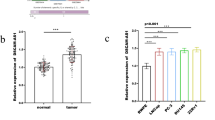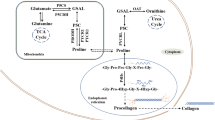Abstract
Pituitary tumor is one type of endocrine tumor with high incidence and mortality rates. Long non-coding RNAs (lncRNAs) are a family of non-coding RNAs with longer than 200 nucleotides. Among them, lncRNA-UCA1 is highly expressed in multiple cancers and plays critically oncogenic roles in tumor progressions. However, the potential roles of UCA1 in human pituitary tumor have not been elucidated. In this study, the expressions of lncRNA-UCA1 were analyzed in thirty pituitary tumor samples and thirty normal pituitary tissues. Cancer cell glycolysis rate was examined by glucose uptake and lactate production. The lncRNA-UCA1 expression was detected by qRT-PCR. Glycolysis enzyme expressions were measured by Western blot and qRT-PCR. Consistent with other cancers, lncRNA-UCA1 was highly expressed in pituitary tumors. Meanwhile, we found glycolysis of pituitary tumors was higher than normal pituitary tissues. Overexpression of lncRNA-UCA1 in rat pituitary cancer cell lines, GH3 and MMQ, significantly promoted glucose uptake and lactate production. In addition, expressions of the glycolysis key enzymes, HK2 and LDHA, were significantly upregulated by exogenous overexpression of lncRNA-UCA1. Importantly, silencing lncRNA-UCA1 obviously inhibited pituitary cancer cells growth and prolactin (PRL) secretion. We report higher lncRNA-UCA1 expression is associated with higher serum PRL level in pituitary patients. Finally, by blocking the lncRNA-UCA1-promoted glycolysis of pituitary cancer cells by glycolysis inhibitor, 2-DG, we obtained recovery of cell growth rate and PRL secretion from an in vitro model. Taken together, our investigation revealed an oncogenic role of lncRNA-UCA1 through upregulating glycolysis of pituitary tumors. This study contributes to underlying molecular mechanisms of the tumorigenesis of pituitary tumors.





Similar content being viewed by others
References
Andersen RE, Lim DA (2018) Forging our understanding of lncRNAs in the brain. Cell Tissue Res 371:55–71
Cocks Eschler D, Javanmard P, Cox K, Geer EB (2018) Prolactinoma through the female life cycle. Endocrine. 59:16–29
Cui M, Chen M, Shen Z, Wang R, Fang X, Song B (2019)LncRNA-UCA1 modulates progression of colon cancer through regulating the miR-28-5p/HOXB3 axis. J Cell Biochem 120:6926–6936. https://doi.org/10.1002/jcb.27630
Dai C, Liu X, Ma W, Wang R (2019) The treatment of refractory pituitary adenomas. Front Endocrinol (Lausanne) 10:334
Fan L, Huang C, Li J, Gao T, Lin Z, Yao T (2018) Long non-coding RNA urothelial cancer associated 1 regulates radioresistance via the hexokinase 2/glycolytic pathway in cervical cancer. Int J Mol Med 42:2247–2259
Glezer A, Bronstein MD (2015) Prolactinomas. Endocrinol Metab Clin N Am 44:71–78
He Z, You C, Zhao D (2018) Long non-coding RNA UCA1/miR-182/PFKFB2 axis modulates glioblastoma-associated stromal cells-mediated glycolysis and invasion of glioma cells. Biochem Biophys Res Commun 500:569–576
Huang J, Zhou N, Watabe K, Lu Z, Wu F, Xu M, Mo YY (2014) Long non-coding RNA UCA1 promotes breast tumor growth by suppression of p27 (Kip1). Cell Death Dis 5:e1008
Icard P, Shulman S, Farhat D, Steyaert JM, Alifano M, Lincet H (2018) How the Warburg effect supports aggressiveness and drug resistance of cancer cells? Drug Resist Updat 38:1–11
Jarroux J, Morillon A, Pinskaya M (2017) History, discovery, and classification of lncRNAs. Adv Exp Med Biol 1008:1–46
Li HJ, Sun XM, Li ZK, Yin QW, Pang H, Pan JJ, Li X, Chen W (2017) LncRNA UCA1 promotes mitochondrial function of bladder cancer via the MiR-195/ARL2 signaling pathway. Cell Physiol Biochem 43:2548–2561
Liu X, Tang C, Wen G, Zhong C, Yang J, Zhu J, Ma C (2019) The mechanism and pathways of dopamine and dopamine agonists in prolactinomas. Front Endocrinol (Lausanne) 9:768
Ma H, Su R, Feng H, Guo Y, Su G (2019) Long noncoding RNA UCA1 promotes osteosarcoma metastasis through CREB1-mediated epithelial-mesenchymal transition and activating PI3K/AKT/mTOR pathway. J Bone Oncol 16:100228
MacLeod RM, MacQueen MV, Login IS (1996) Prolactin secreting cell line and method of obtaining the same; US Patent 5,510,260
Mete O, Lopes MB (2017) Overview of the 2017 WHO classification of pituitary tumors. Endocr Pathol 28:228–243
Schwartz L, Supuran CT, Alfarouk KO (2017) The Warburg effect and the hallmarks of cancer. Anti Cancer Agents Med Chem 17:164–170
Tashjian AH Jr, Yasumura Y, Levine L, Sato GH, Parker ML (1968) Establishment of clonal strains of rat pituitary tumor cells that secrete growth hormone. Endocrinology 82:342–352
Trifiletti DM, Dutta SW, Lee CC, Sheehan JP (2019) Pituitary tumor radiosurgery. Prog Neurol Surg 34:149–158
Wang C, Xu JL, Wen Y, Zhang DZ, Wang X, Chang L, Li GF, Xie LY, Su J, Zhang XX, Tan CL (2018) Fulvestrant inhibits the glycolysis of prolactinoma GH3 cells by downregulating IRE1/XBP1 signaling pathway. Eur Rev Med Pharmacol Sci 22:5364–5370
Wang H, Guan Z, He K, Qian J, Cao J, Teng L (2017) LncRNA UCA1 in anti-cancer drug resistance. Oncotarget 8:64638–64650
Wu H, Zhou C (2018) Long non-coding RNA UCA1 promotes lung cancer cell proliferation and migration via microRNA-193a/HMGB1 axis. Biochem Biophys Res Commun 496:738–745
Zhang Y, Liu Y, Xu X (2018) Knockdown of LncRNA-UCA1 suppresses chemoresistance of pediatric AML by inhibiting glycolysis through the microRNA-125a/hexokinase 2 pathway. J Cell Biochem 119:6296–6308
Acknowledgments
The authors thank the doctors and faculties working in the Department of Internal Medicine of Tianjin Huanhu Hospital, Tianjin City, China. We thank Dr. Yi Li for providing the editorial assistance.
Author information
Authors and Affiliations
Corresponding author
Ethics declarations
Ethical approval and informed consent were obtained from the Ethical Committee at the Department of Internal Medicine, Tianjin Huanhu Hospital, Tianjin, China.
Conflict of interest
The authors declare that they have no conflict of interest.
Additional information
Editor: Tetsuji Okamoto
Rights and permissions
About this article
Cite this article
Liu, G., Wang, L. & Li, Y. Inhibition of lncRNA-UCA1 suppresses pituitary cancer cell growth and prolactin (PRL) secretion via attenuating glycolysis pathway. In Vitro Cell.Dev.Biol.-Animal 56, 642–649 (2020). https://doi.org/10.1007/s11626-020-00494-x
Received:
Accepted:
Published:
Issue Date:
DOI: https://doi.org/10.1007/s11626-020-00494-x




